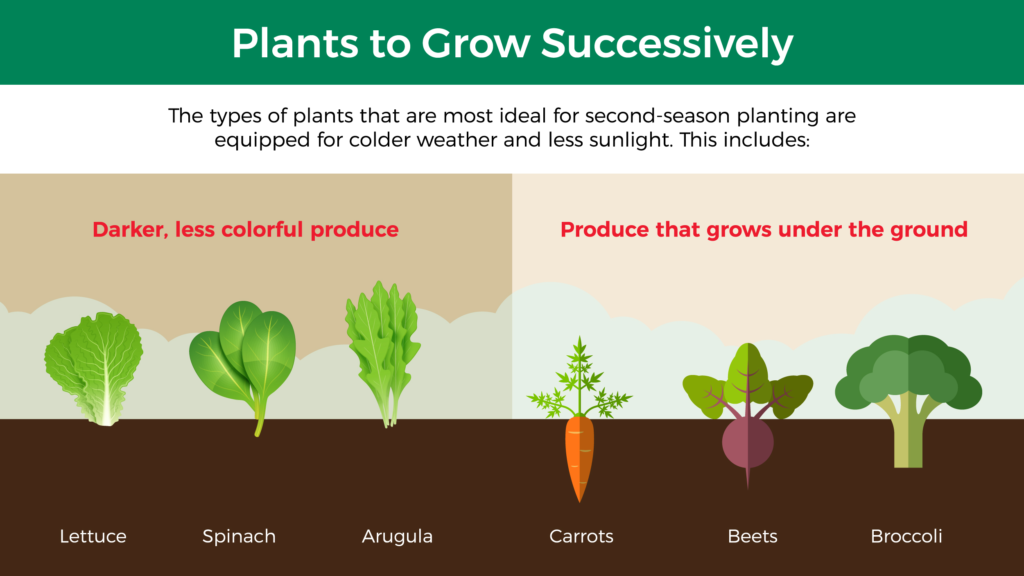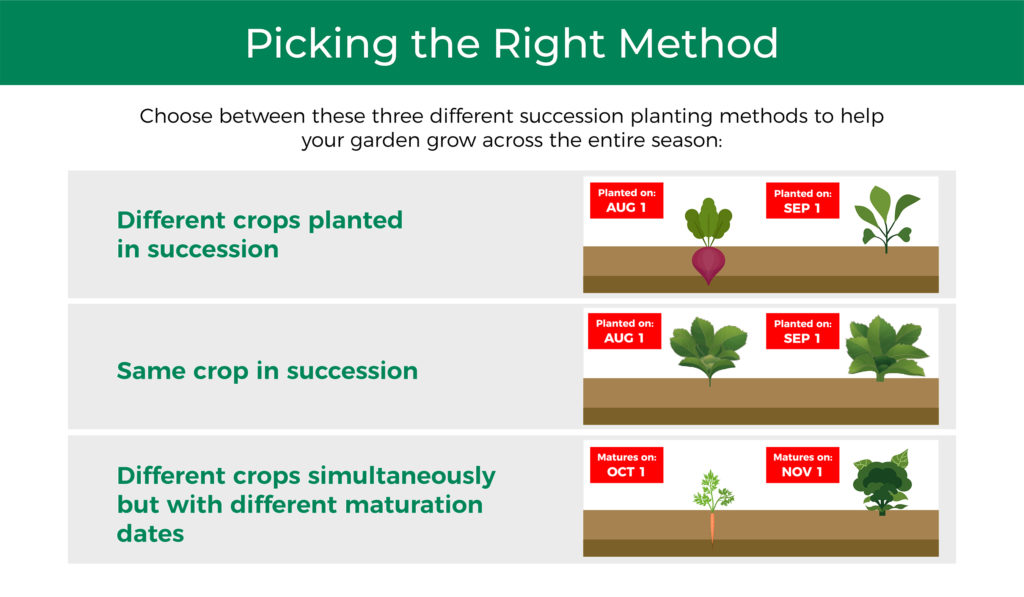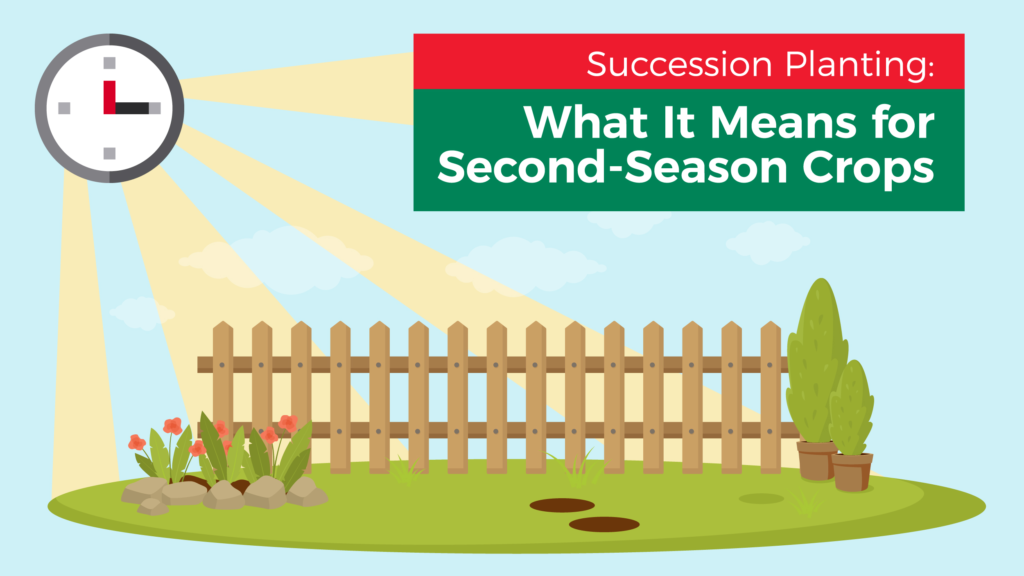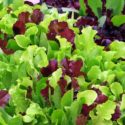Homegrown vegetables are a delight throughout the spring and summer months, but with succession planting, both farmers and backyard gardeners can produce these family favorites for up to nine months out of the year. Succession planting refers to several planting methods where an additional crop is planted immediately after the initial one is harvested. It is perfect for efficient edible gardening as it helps extend the growing season and produce a continuous supply of vegetables.
While the timing of succession planting varies depending on your region’s weather, frost dates, and the plant varieties you prefer, the second seeds are typically sown at some point during late summer. This way, summer crops can be replaced with cool-weather plants that can endure light frosts, dropping evening temperatures, and shorter daylight hours.
When to Plant
When planting a successive crop, it is important to not delay. Anything planted in the ground will need time to mature before the first expected fall frost, and as the days become shorter and colder, plant growth will slow down and result in a longer time to reach maturity. To determine the date of your last possible sowing, it is recommended to count backwards from the region’s anticipated first frost date, adding an additional two weeks to the maturation time on the back of your seed packet to account for slowing growth patterns.

Timeline noting that second-season crops should be planted with an additional two weeks of maturation time before the season’s first frost
To ensure speed and efficiency while gardening, your current crops should be pulled out as soon as they have passed their prime. But, be sure to keep your soil health in mind, too. By growing more crops in the same plot, you’ll use more nutrients. So, before planting new seeds, you should look to replenish these nutrients with a granular organic fertilizer.
Another thing to keep in mind when planting in the heat of summer is the temperature- and moisture-levels in the soil. Your second crop of cool-season plants won’t germinate well if the soil temperature exceeds 80 degrees, and the seeds may die if the soil dries out. To avoid these issues, seeds should be sown twice as deep as your spring seeds. Using a Easy Gardener Sun Screen will also help cool the soil for second crops and can be taken down at the first sight of green sprouting through the soil.
What to Plant
When choosing what varieties to grow, try picking plants that work with the weather, not against it. The best plant varieties to sow in late summer are those that mature quickly and thrive in cool weather and less sunlight. This includes salad greens such as lettuce, spinach, and arugula, as well as other vegetables like carrots, beets, and broccoli.

Plants that are better equipped for colder weather include darker, greener plants and those that grow underground
In the case that the frost arrives early, growing vegetables like carrots, peas, beets, and beans are a safe bet, since they can be harvested before reaching full maturity. But, if winter wind, icy rain, or frost strike before your other vegetables fully mature, you can also shield them with protective blankets or wraps.
Be sure to consider crop rotation while vegetable gardening, too. Planting the same or related seeds after pulling up the previous crop could lead to soil disease and pest build-up. As a rule of thumb, avoid planting a vegetable in the same spot it has been planted in the last three years. Instead, switch to a new variety and plant a second round of your favorite vegetable elsewhere. Your soil will thank you, and your garden will yield better tasting produce!
Choosing a Planting Method
Depending on your goals, there’s a few different succession planting techniques to choose from. Whether you’re wanting to grow at an edible rate or get the absolute most out of your small garden space, one of these methods is sure to suit you.

There are three different succession planting methods: different crops in succession, same crops in succession, or different crops concurrently with different maturation dates
Different Crops in Succession
The most common succession planting method is following the current crop with a different species that is better-suited for the late-summer and fall conditions. For example, one may plant eggplants at the start of spring, so they can thrive in the high temperatures and long sun exposure. Then, once the eggplants have passed their harvest peak, they can be replaced with a plant that can withstand the cooler fall temperatures, like cabbages. This technique only requires one sowing session and is suitable for those wanting a relatively easy way to get the most out of their edible gardening.
Same Crop in Succession
Commonly known as staggering, the same crop method encourages gardeners to time smaller plantings of the same vegetable at regular intervals. By doing so, the vegetables will mature at different rates and provide you with a continuous, yet manageable, crop. This is regularly seen with salad greens, such as when rows of lettuce are sowed a couple weeks apart. This approach not only extends the length of your harvest but also prevents the waste of excess vegetables.
Different Crops Simultaneously
While growing crops simultaneously may not sound like succession planting at first, this method is ideal for those who are extra eager to make the most efficient use of their garden space. Also called intercropping, this technique starts with a single sowing session for two different vegetable varieties. The succession is then seen in the different maturation dates of the crops. Rather than the planting being staggered, the timing of the harvests differs.
For example, fast-growing plants like lettuce can be planted around slow-maturing varieties like kale. The lettuce will be ready for harvest before the kale gets too large that it shades the lettuce, and once the lettuce is harvested, the kale will have enough room to finish growing. As long as you choose vegetables that will not have detrimental effects to the growth of one another, this method is a tried-and-true way to effectively use every inch of your garden space.
Finding Success in Succession Planting
Succession planting is an efficient way to take your vegetable gardening to the next level, and at Jobe’s, we offer a wide range of products to support your endeavors. With a variety of options for eco-friendly fertilizers, soil amendments, and cold-weather protection accessories, you can trust that our products will help bring food from the garden to your table all season long.



